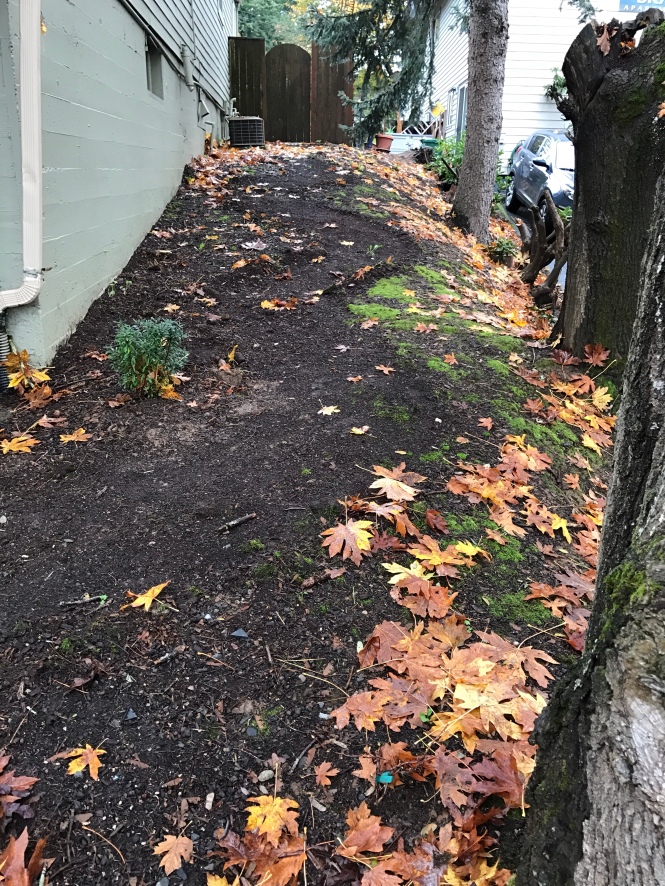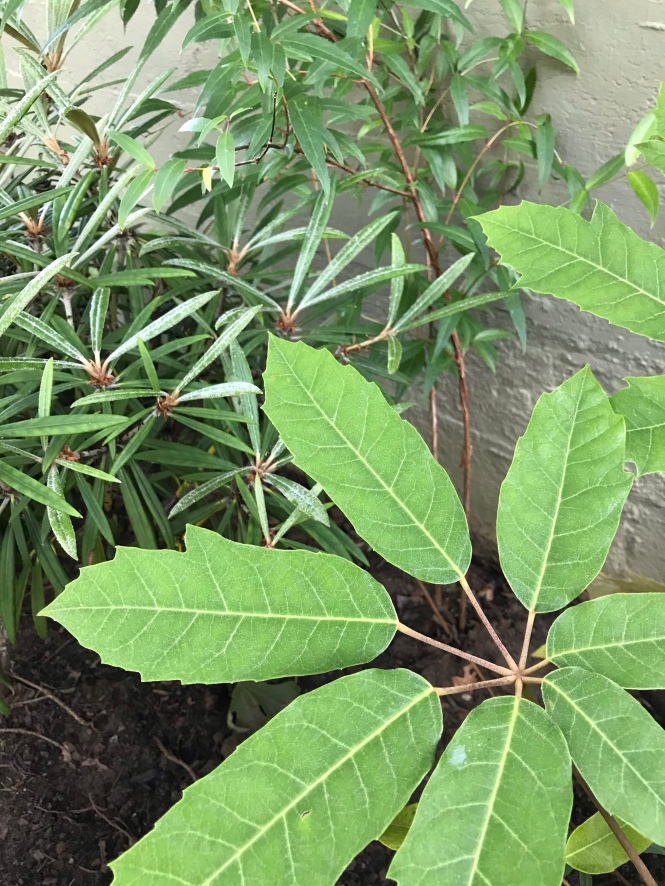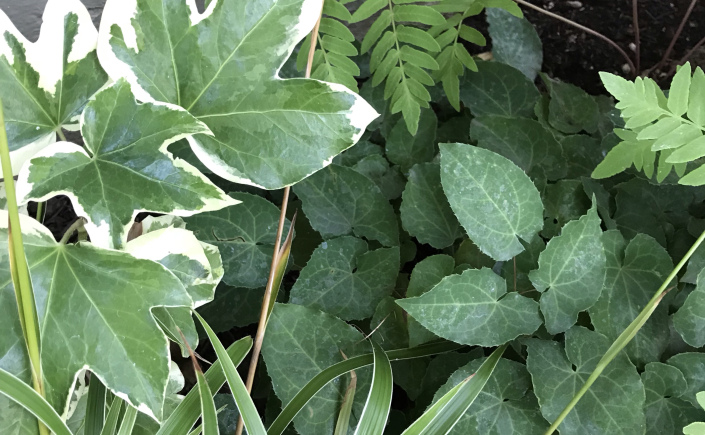I have a love/hate relationship with my shade garden. (I chronicled the beginning here in earlier blogs I Never Promised You a Shade Garden… and I Never Promised You a Shade Garden…Part Deux. )On one hand, I get to explore an entirely different array of plants than the rest of my sun loving garden, but on the other, gardening there is a pain in the butt! Rich, moisture retentive soil against the house on one side and a bone dry root laden slope on the other have made plant selection and siting challenging, especially for someone learning as they go!

The original blank canvas
Needless to say, this has been an adventure and trial and error has become the norm here. Two full seasons have passed and I’ve learned a lot about gardening in the shade.

The first plantings
Fast forward two years…

Daphne x transatlantica Eternal Fragrance will be the star here eventually but right now the moss steals the show!
First lesson: It’s all about the Benjamins:
This is a BIG space and needs lots of plants! Also, about half of this space (the slope) has been “guerrilla gardened” as it is my neighbors property. I try to be as cost conscious as possible with plant selection here and shop end of season sales and discount corners of nurseries for deals. Matthew The Lents Farmer has been very helpful over the years with hosta and fern divisions along with fabulous finds from and so has our semi-annual swap with my very generous blogger friends! My neighbor even chips in a few bucks every now and then to show her appreciation!

Aspidistra elatior ‘Okame’, Aspidistra hainanensis ‘Jade Ribbons’ and Hydrangea integrifolia
Second lesson: Read the damn tags!
I know, I know. I’ve said this before and I do read them but sometimes I just want them to be wrong! I’ve had to move or lose multiple heucheras and astilbes (to name a couple) because I insisted I could make them work where I put them! If you look closely you might notice some unintentional before and after photos from this summer!

Pseudopanax “Sabre’, Podophyllum ‘Spotty Dotty’, Hemiboa subcapita
Third lesson: Treat yourself!
Buy what you love! Over the next few years I’ve accumulated a few plants that will become anchors in my garden therefore were worthy of spending a few extra dollars to get what I really wanted. My Psuedopanax ‘Sabre’ (I know I’m tempting fate), Fatsia ‘Camouflage’ and Fatsia ‘Murakuma Nishiki’, ‘Rhododendron makinoi and Dan Hinkley’s Hydrangea “Plum Passion’ and Schefflera delavayi were all must haves and hold special places in my heart.

Hydrangea “Plum Passion’ and multiple Hakonechloa ‘All Gold’ and ‘aureala’
Fourth lesson: Keep it simple
For those with more design prowess, you probably would have been more successful but I tried to do too much with too many types of plants on my slope. It felt chaotic. By the end of the summer I cleaned it up and simplified things by creating smaller zones each containing fewer types of plants. In the end, it felt better and I’m looking forward to seeing how it turns out next season.

Viburnum rhytidophyllum and Fatsia japonica ‘Murakuma Nishiki’ in the background
Fifth lesson: Be patient
I’m pretty sure this is another lesson I keep learning over and over. A full, lush, tall shade garden does not happen overnight or even in a few years. I takes time and is a journey.



Rhododendron makinoi and Schefflera delavayi is a favorite combination
You my have noticed my omission of fern identification. You’re correct. I’ve done a terrible job of record keeping on my ferns so I’m just going to leave it at that.

I’m a sucker for all forms of variegation. Luzula sylvatica “Marginata, Fatshedera ‘Angyo Star’

Fatsia japonica at the entrance
Each spring I look the shade garden with the most anticipation. I’m excited to see how it will evolve this year!

Your shade garden has come a long way from the beginning only a few years ago. The Fatsia has grown so big (and you know it should get even taller). You’ve filled this garden with some really choice specimens and learned some valuable lessons. I know you said you haven’t kept track of fern names, but two of my favorites that you might try are hart’s tongue (Asplenium scolopendrium) and Scouler’s polypody fern (Polypodium scouleri) — both nicely drought tolerant.
LikeLike
Thanks for the recommendations! I’ve had trouble finding drought tolerant ferns…I’ll look for these two!
LikeLike
It’s looking great! Someday I’ll learn the keep it simple lesson. My garden is a cacophony of one of whatever caught my eye that day at the nursery.
LikeLike
Thanks Peter! I love it..cacophony! The rest of my yard feels like that!
LikeLike
Wow, it looks amazing!! Nice work and learning as you go is really the only way…
LikeLike
Thank! If only the poor plants didn’t have to suffer along the way, lol!
LikeLike
In the redwood forests, shade is the norm. There is nothing we can do about it, but plants what tolerates the shade, . . . or leave it bare with redwood duff. #4 is very important, and makes it easier to maintain the fewer plants that do well, rather than trying to give the weaker plants a bit of help as the languish. I mean, there is no point in adding a lot of plants if only a few happen to be doing the job.
LikeLike
Pretty impressive transformation for only a few seasons! I like the way you simplified the beds this years. The plants really stand out! Happy New Year!
LikeLike